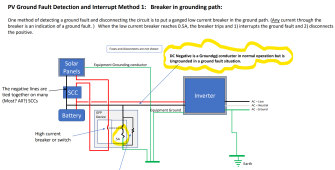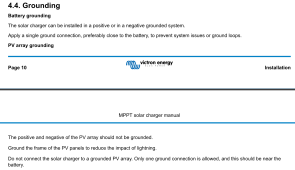I'm installing a ground mount solar system with an 8S3P panel configuration. It will have a maximum Voc of 424 VDC in winter. The panel Isc is 8.9A so with the 3 parallel strings, it would be rated for 26.7A. The PV circuit will need to be sized for => 41.7A. The inverter I am using is an MPP LVX 6048 and the manual requires the PV array to float. I'm curious to what others have used with similar floating inverters with high DC voltage to comply with NEC 690.41(B) Ground-Fault Protection? The solutions I am finding cost as much or more than the inverter or they require the battery (-) to be grounded. I do not believe the LVX 6048 will tolerate a grounded battery though I do not see that it says one way or the other in the manual. Bench testing the inverter, the battery does center itself about earth ground. Ideally, a differential DC relay would be used to shunt trip a DC breaker but I have yet to find a cost effective solution.
Thanks, Bill
Thanks, Bill





